The Time We Pulled Tape at Dylan: Remembering Clay Brennecke
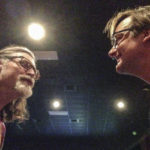
Clay B and me, front
of board, mics well hidden, we
made a fine, fine tape.
Not my best writing, this haiku, but I composed it while grieving over the news that my old friend Clay had passed away, and under personal circumstances of a sudden and tragic nature. Maybe I wanted to cheer myself up; maybe I just needed to smile at a better memory.
Later, I wrote more: this essay in tribute to a fallen, sweet soul. I hope it conveys my respect, love, and props to not only a dear friend of over twenty-five years, but one who got me interested in a fulfilling hobby, perhaps even an avocation: making audience recordings at live concerts. Sometimes with permission, sometimes not. This is about one of those times.
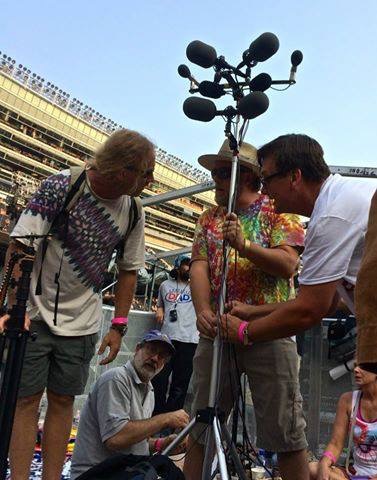
Clay (right) and friends getting ready to tape one of the Fare Thee Well concerts, July 2015.
Columbia, SC music lovers met the news that Bob Dylan was coming to the Township Auditorium in November 1997 with enthusiasm—the poet laureate of rock had been on a personal upswing, with a new album, Time Out of Mind, that had been received with critical and public acclaim unlike anything he’d produced in some time. He’d begun doing a few Jerry Garcia tunes in tribute to his touring partner and fellow musical icon who had departed his broken body two years before, and also in that time seemed to be sharper, more invigorated onstage, and now, with a new album of haunted songs that felt weighty and atmospheric.
I simply had to record it.
Unlike at Grateful Dead concerts where I’d cut my teeth making live audience recordings—there, the activity was fully sanctioned and managed by the band—Dylan’s people, like those of most musical acts, were hard on “bootleggers” and wouldn’t dream of letting anybody make a recording. But where the will exists…
Especially with a taper like Clay Brennecke, who had reputation for fearlessly unauthorized taping. An aficionado of peak experiences, Clay would never turn down a challenge.
Me, not so much—by then I had plenty of experience “pulling tape” at Dead shows, Phish concerts, a few smaller bands like my friends the Zen Tricksters out of Long Island, who would let me patch in my DAT (Digital Audio Tape) deck into the soundboard. I was mostly content to be in the official tapers section, but even in that environment a certain segment of recording aficionados wanted to tape “front of board,” referring to the soundboard through which all the electricity from the stage flowed before it got turned into amplified sound waves (and captured by tapers).
Clay had explained taping this way to me: the ultimate goal was to capture the sound of the band as it occurred in the concert hall, with as little distortion from the limitations of the microphones and room as possible.
A note about taping: while individuals have certainly recorded concerts with the intention of ripping off bands and making or otherwise selling bootlegs, this represented a serious ethical violation among tapers who came out of the Dead scene, who possessed an ironclad bond with that band: they’d let us record, but for “personal use only.” For the faithful Deadhead having access to literally thousands of circulating audience recordings, this bargain was an easy one to make.
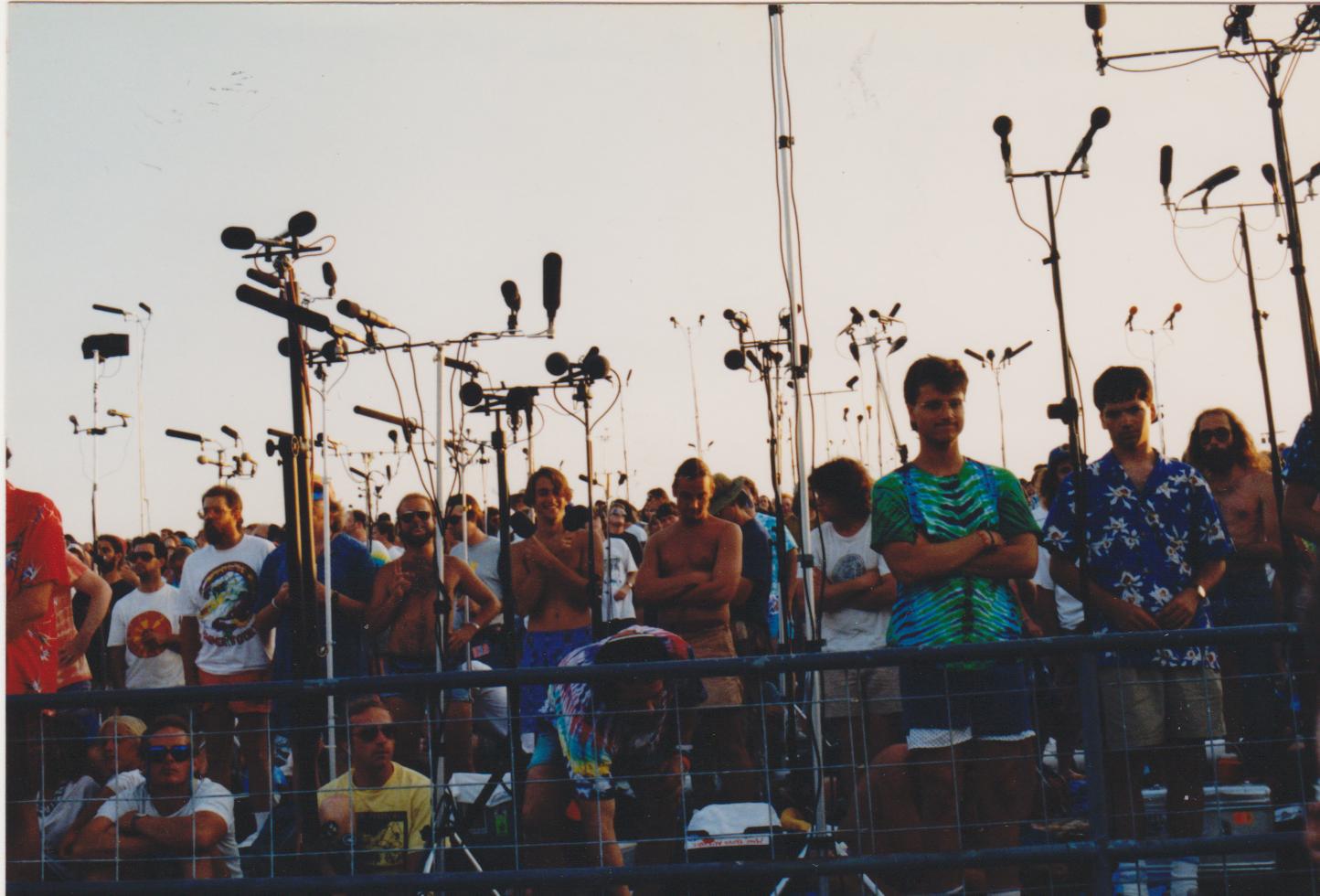
Clay, shirtless in the center and looking down at the gear, taping the Grateful Dead in June 1991.
As for other acts, most would not only consider the act of audience taping as theft, but guys like Clay were in it for the thrill of the hunt, the rush of walking undetected. Ejection would occur at a minimum for the infraction, but maybe not if you offered up the master, if somebody from the band wasn’t already demanding it. Experienced hands know in case of being busted to keep a dummy tape in a pocket to use a proxy in a negotiated handoff to an authority figure. A little sleight of hand with the gear, and here you go. Sorry. Won’t happen again.
Clay not only got caught a few times, but on one memorable occasion two years earlier, had managed to record the encounter. This story that was on my mind as we prepared to record Bob Dylan.
Still in mourning from the death of Jerry Garcia in August, that autumn I assuaged my grief by dragging myself to a number of concerts including Phish in Atlanta, where I hooked up with a number of friends to share a hotel room across from the fabulous Fox Theater during the band’s first and so far only four-night run at the storied old venue on Peachtree.
Inside the venue, with its painted cloud– and star–scape marching slowly overhead, those of us recording from within Phish’s official section got our gear set up, a process and tradition worthy of its own scholarly attention.
I asked Jimbo, whom I had helped mentor into the taping scene the way I had been by others, “Where’s Clay?”
“Down front,” with an exasperated tone. “He’s just got to run FOB.”
“FOB’s not such a bad idea.” Front of board would make for a cleaner tape, the proximity to the “sweet spot” allowing a better sonic reproduction to be captured, at least when compared to the official section, which had been placed under the balcony. Reverb would be an issue, phasing problems, who knew.
But FOB was more difficult on your own. It helped to have a partner.
The last notes of a Rolling Stones cover, “Loving Cup,” rocked us out of the Fox Theater and into the cool Atlanta nighttime. I never saw Clay again until outside the show, which had been strong and exciting. He came marching up to us through the throng of phans with an enormous grin on his face, the Kirk Douglas dimple piercing his chin deeper than ever.
“I got busted.” And yet he was laughing.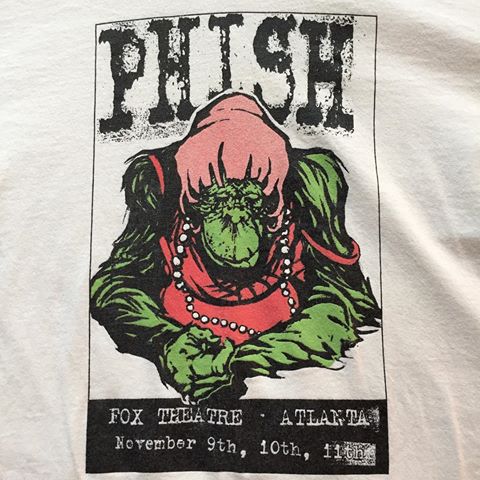
“They kicked you out?”
Nodding; but still laughing. “Yeah—but I taped it.”
We’d soon hear the result: we sat in Jimbo’s Honda in the hotel parking garage, playing back Clay’s DAT recording of part of the band’s first set, and then the entirety of his encounter with Phish’s band management, as well as an Atlanta cop.
The conflict, already muddy to the cop who ended up interceding, had to do with the fact that Clay was recording the concert, which Phish allowed, but doing so FOB meant he was in the “wrong place.” The band representative argued not only for Clay’s ejection, but you guessed it, surrender of his partial first set tape, which could be heard thumping from the lobby area where they had taken him.
We sat in the car howling with laughter as we listened to Clay making the legal case that no one had any right to seize his personal property, which the tape in the deck most certainly was. The band rep argued no; the music on said tape belonged to Phish, and that under this rubric they had every right to demand the “unauthorized” tape.
“But you can’t seize my personal property—I haven’t broken any laws. It’s a rule of the venue, in this case modified by the band to allow for taping. The fact that I was standing in the wrong place gives no one the right to take my personal property, out of my bag and seize it from me with no recourse . . .” And so on.
The cop got impatient and broke in: “It’s cut and dried. He doesn’t have to give up the tape.” But ejection, that was non-negotiable, and Clay sat out the second set at a nearby diner, waiting for us, and to not only hear the story, but listen to his crystal-clear, all digital recording on the hot microphones he had hidden during the entirety of the encounter.
The next day my stomach hurt from laughing, reviewing the tape in that car with wonder at Clay’s adrenaline-junkie moxie. His only regret, truly, had been not pulling a good tape.
Only weeks before, I had stealth-pulled a couple of Bob Dylan shows, and nearly gotten busted when they had turned on the houselights at one of them during the final song, “Rainy Day Women #12 & 35.” A couple of stagehands standing by the stacks saw me futzing with my gear, nudged each other and pointing. After Atlanta, I was doubly glad I had made it out of that Dylan show unmolested. I wondered if I would have handled talking my way out of a taping bust the way Clay did at Phish.
Clay view events like this as a badge of honor. He even wanted to publish a book about taping misadventures called Tales of Taping Terror. He made up a flyer and handed it around to other tapers, essentially asking them to contribute similar experiences of taping failure to his book project, for pretty much no remuneration other than the glory of sharing the ignominy. It wasn’t that he thought he’d make money on it, or maybe he did, but Clay, always practicing entrepreneurship of one kind or another—selling homemade T-shirts outside the shows, his book idea, and so on, but never bootlegging and selling the music, never violating the taper code.
Share your stories, the book flyer begged. Live forever! it promised.
I never heard if anyone actually sent him any stories. The best I could do was that Dylan near-bust, but it wasn’t even a thing—I walked out with a clean tape.
Besides, Clay already had all the good stories—his own. Sneaking gear inside. Almost getting busted. Getting busted. Making fantastic tapes. Other folks than me could tell you the best stories, guys he traveled with. In fact, I’m not sure why he thought he needed other people’s stories. Out of a sense of community, I suspect. Tapers, by nature a competitive lot, but also tribal, speaking a common language. Brothers, and even a few sisters. He felt at the vanguard, and in the fraternity, of a “new sport,” as Clay liked to call it the adventure that was pulling tape, both legitimately and otherwise.
As well, Clay made these taping projects personal affairs. Anyone who heard one of his tapes all the way to the end would find out they concluded with his “tag,” identifying himself and the rest of the team behind that FOB or taper section pull. (Many of these can be heard by clicking through to the link at the end to the archive.org recordings.) Charming, cheerful, Clay, calling out to the world—to posterity—with his little greeting and report about the capture he’d made of that evening’s sound waves.
On one recording I recall, at which there seemed to be no other stealth tapers (a Jerry Garcia Band concert that featured no official taping policy and section), Clay’s tag at the end doesn’t simply note the data surrounding the recording, but exhorts other tapers to “get their butts out on the road and make some masters. C’mon!”
That was Clay. Few who crossed his path could forget his enthusiasm and sparkle. And while life took us in different directions after Garcia’s death—Clay to Charlotte to work for Microsoft, me from my job at the university to new career owning a Deadhead-themed clothing store in the college neighborhood nearby; another story—we would still run see each other fairly often, and even take in a show together.
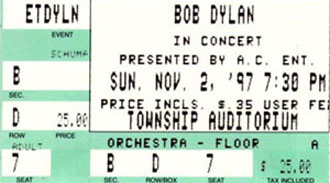
Two years after my almost-bust at that Dylan show finds the legendary songsmith bringing so-called Endless Tour winding not only through the South again, but this time Columbia itself, a market his act had hit three times since I first saw him at the basketball arena in 1986, a weirdly inscrutable and alienating performance compared to his recent onstage demeanor—that was Dylan. One never knew what to expect. Not a bad thing in a artist of such stature and longevity.
Clay and I both snagged floor seats, decided to really be ballsy and hand-hold the cardioid fixed-capsule Neumann KM-54s on a T-bar screwed onto a custom-made handle he had constructed from a bicycle grip. Standing stock-still, wearing a black shirt and with a shank of black speaker cloth over the small mics, it was possible to go relatively unnoticed with this rig, as I had found out at that prior Dylan show.
It gave me pause. But we were deep in the crowd on about the tenth row, a little off center, but it would be fine.
Except when we got inside, the gear successfully smuggled and tucked away, and my mom, a huge Dylan fan who had probably gotten us the good tickets through a work connection at the venue, had a conniption. “Y’all are not going to get me thrown out of this Bob Dylan concert!” Out of her few Dylan shows, this was probably the closest she had been to the stage, and she didn’t want any shenanigans.
The details of this next part are hazy, but somehow we ended up swapping tickets with someone a bit farther back, and on the other side of the center-aisle floor section at the old Township Auditorium, seats we discovered were literally right in front of the soundboard. A good spot from an aural standpoint, true. But right in front of the soundman himself. Who works for Bob Dylan. Who has been bootlegged to death in his career, and is in no way friendly to audience taping—in fact, when he did a tour with the Dead as his backing band, he forbade their usual official taper section.
“I guess that’s that.” I put the bag of gear down.
Clay reached inside, started getting the mics together. We couldn’t be seen by anyone much, and certainly not the soundman, not over the top of his huge board. I had on a black T-shirt and a black US Army field jacket with the speaker cloth folded neatly in one pocket. Clay seemed to think there was no question that we had to try, but not only that, time had run short on us, and the lights went down.
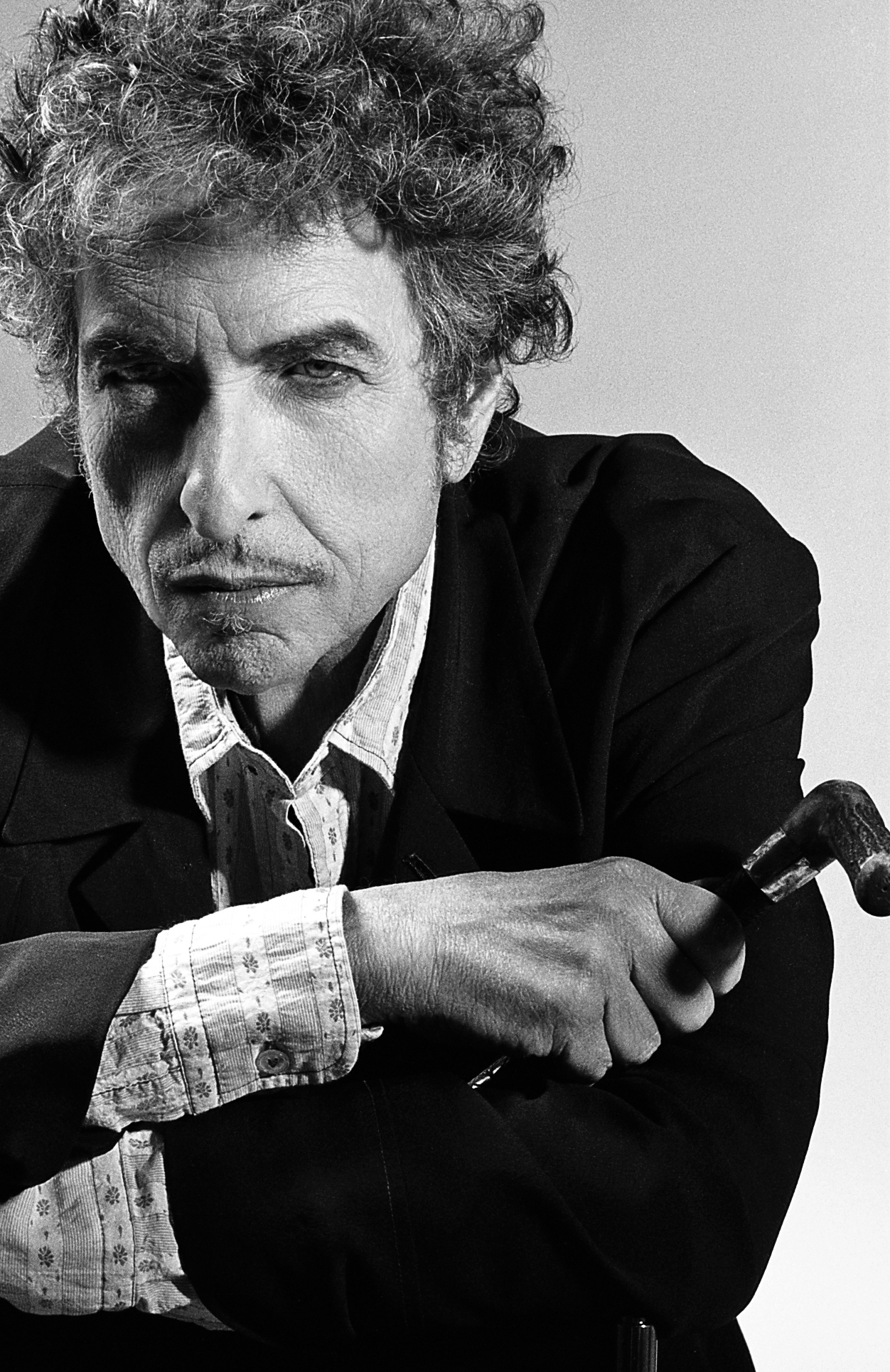
© Uploader Unknown. All Rights Reserved.
The origin of this image is unknown. If you are the rightful owner of this image and are not credited, contact me.
We had gotten up and running halfway into the first song, the classic “Maggie’s Farm.” To view the gear in the bag, Clay used a stealthy red flashlight that I had gelled rather than the Sony tape deck’s bright blue backlight feature, which would light you up from below like the electronic glare from today’s smartphones and tablets. Thumb’s up. Good levels.
I stood holding the mics against my black shirt, a human statue throughout Dylan’s ninety-minute set and encore tunes. But I felt safe as a kitten, even when the house lights brightened during “Rainy Day Women #12 & 35.” Despite our proximity to the person probably most inclined to shut us down, I never expected to feel the hand of the soundman or stage crew on my shoulder. Even if anyone else had noticed our wires, we were standing inches from a nest of wires and audio gear. We faded into our background like wildlife employing natural camouflaging techniques.
But more than that, Clay was more experienced at stealth taping than I was. I had only gotten into going FOB at Dead shows in the last tour or two before Jerry died. I hadn’t gotten to wear the Schoeps in the hat or handhold the Neumanns until later, at shows like Dylan. And being with Clay that night felt comfortable. He had gotten me into this whole taping deal, had encouraged me so much. But we really never had a taping adventure, just the two of us, like Dylan at the Township.
Through the years, both before I knew him and afterward, Clay often went through all sorts of personal problems, some to which I have been no stranger—struggles with substance abuse, alcohol, and so on. Clay had an adventurous streak in that regard as well. He had no fear. He liked to live on the edge. He went through a rough patch. I worried about him. His plight helped inspire a character in my novel Fellow Traveler, so broken after the death of his musical icon that he retires from life and taping, trapped in his old childhood room surrounded by the tapes, addicted both to drugs and the recordings, a literary metaphor. And not only Clay, an amalgam of several people I’ve known, but also myself, a voracious tape collector and Deadhead to the point that my entire adult life has revolved around the band and its music, the sociological scene as well, in particular the taping. I have Clay to thank for so much of that involvement and enjoyment I’ve gotten out of life.
Clay pulled out of his downturn, instead grabbing hold of life by marrying and starting a family, “settling down” as it is said, in his forties. While he left other old habits behind, he never stopped taping, including not only lots of local music in the Charleston, SC, area, but a triumphal moment when he and his friend Jeff flew to the UK to attend the famous Led Zeppelin reunion concert, and pull a sweet FOB digital tape. It came off without a hitch. I know Clay felt like he had really grabbed a brass ring with that one. Watching the DVD of the official concert release a few years later wasn’t nearly as thrilling as cranking up Clay’s audience pull. A fine tape indeed, even if it isn’t tape per se anymore. Hard nomenclature to break.
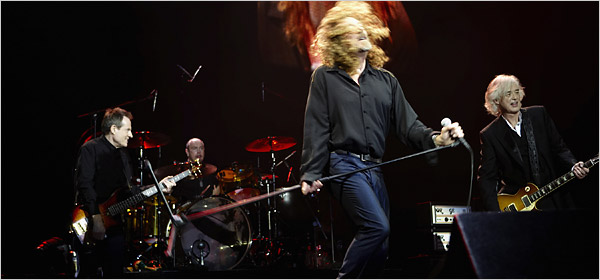
Photo ©2007 NY Times
By fifty, however, not only had we mostly lost touch, but it seems Clay had encountered not only old problems, but also health issues stemming in part from years of adventuresome behavior. When it all got to be too much, and personal pressures increased beyond his capacity to control, he ended up making a tragic decision.
The news hit me hard. He’s not the first of my friends to make this awful and final choice, but one of the last I probably would ever have expected: every time I had ever seen Clay, even when he had sought me out because of this or that difficulty, always remained for the most part cheerful, optimistic, and kept that certain twinkle in his eye that let you know he had everything under control.
It’s sad that I’ll never get to see that twinkle again, but at least I’ll have the memory of my friend Clay—not only the night we taped Dylan, but all the wonderful times we shared together. Camping out for Dead tickets all night in the Charlotte Coliseum parking lot while listening to the tapes he’d made out in Vegas. Helping him pack to get ready to go on a cross country trip. Years later, sitting with other knowledgable Deadheads and doing a close listen and analysis to a recording of one of the post-Garcia iterations of the band. And yes, taping the Dylan show together, which on my copy doesn’t seem to feature one of Clay’s taper tags. I think we were in a hurry to stash the gear—we had gone balls out to make that pull. No way could we stand for being caught. Not after getting the whole show, handheld with the Neumanns, in the sweet spot, in front of a music legend.
I know that with these memories and more I will always carry a bit of Clay’s spirit inside, honoring and remembering all that his friendship made possible. And whenever you hear a rare audience field recording of a band you love, remember to thank a taper like Clay Brennecke. And for those of you “tape,” still, do what Clay would want: get out there and make some masters.
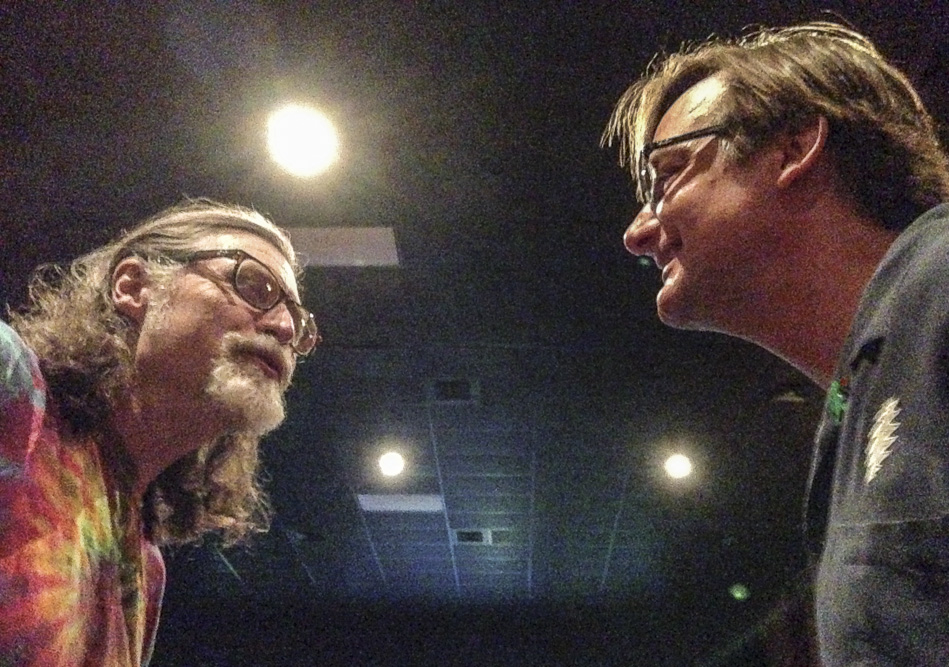
The author and Clay Brennecke ran into each other at the 2014 Grateful Dead Meet-up at the Movies, a fond reunion.
Clay Brennecke recordings on archive.org
The Setlist: Bob Dylan Township Auditorium, Columbia SC Never Ending Concert Tour, Show #913
1. Maggie’s Farm 2. Pretty Peggy-O 3. Cold Irons Bound 4. Born In Time 5. Can’t Wait 6. Silvio 7. Stone Walls and Steel Bars (acoustic) 8. Tangled Up In Blue (acoustic) 9. Tomorrow Is A Long Time (acoustic) 10. Friend Of The Devil (acoustic) 11. Make You Feel My Love 12. ‘Til I Fell In Love With You
Encore 13. Like A Rolling Stone 14. My Back Pages (acoustic) 15. Love Sick 16. Rainy Day Women #12 & 35
Notes: Maggie’s Farm fades in. Good stereo image, clear highs, a solid low end with only a little boom from the room. A solid, enjoyable recording.
About dmac
James D. McCallister is a South Carolina author of novels, short stories, journalism, creative nonfiction and poetry. His neo-Southern Gothic novel series DIXIANA was released in 2019.
Beautiful memories.
I knew Clay from the late 80s thru 95 on tour. He was always the most upbeat guy. Stood by him several nights holding mics. He was always encouraging me to go for more.
Lost touch after Jerry passed but we had reconnected in the last few years. One of the coolest things when we reconnected was when he sent me a scan of a card I had sent him back in 1991 … he had kept the damn thing all those years.
God didn’t make many like our friend Clay …
When Fare Thee Well was announced, I started a Facebook page called Grateful Hoosiers and Friends for a way for Indiana people to connect. Got a random message from a guy named Clay, trying to help swindle (or at least call out) a member who was selling tickets for over $1000 each! He wanted to keep the tickets in the hands of true fans – and I loved it. I tried like crazy to find him on the first night of FTW but he hadn’t gotten down to the tapers section yet – and it was such a zoo I never made it back. He sent me some drawings and links afterwards, and a special item from someone in the GD organization for my daughter Sophia (now 7). It broke my heart what happened and I never physically met him. We discussed our kids and our love of the Dead and other bands. I felt as though I knew Camden. So I can’t imagine the pain of those who knew and loved him. I went out to San Fran for the Dead & Co shows in December and felt his spirit at the microphones, and took a picture from the middle of them that is haunting and beautiful.
Having researched thoroughly the legal issue of bootlegging, I take credit for having schooled Clay on refusing to relinquish copyrighted recordings because an infringed party needs a court order to enforce a seizure. The mere recording is a civil wrong, the sale of such recordings becoming criminal. Interestingly, whereas a recording of a copyrighted song was an infringement, the recording of a cover song by the Dead was not actionable by the Dead but rather by the copyright holder. This was the law until a few years ago when the Congress created a Performer’s copyright in any performance of music- covers or otherwise.
None of this discussion precludes the ejection from the venue for trespass, that is, exceeding the limited license of taping in the taper’s section or taping at all where it was prohibited altogether. Still, I counseled Clay not to relinquish his private property in the face of a threat. Regrettably, few tapers knew their legal rights.
I am the Jeff who accompanied Clay to the Led Zeppelin show.
Good to hear from you, Jeff. Clay indeed always gave you credit for informing him about such legal matters, of which he certainly had a firm grasp during that Phish taping bust. He was also quite grateful for the Led Zep adventure and many other things throughout the years.
I patched out of the AMS rig at the Phil & Friends Oct 1999 shows with Jeff & Rob from the Zen Tricksters, also came over to your house for a bit on that trip. Good times.
Nice tribute you wrote for Clay. I wish I had a literary friend to write my in memoriam!
I just ran into a “Tales of Taping Terror” flyer while going through my Grateful Dead memorabilia. This is the only article on the internet mentioning it. Too bad nothing ever came of the idea. It’s a fun flyer to have!
Thanks so much for writing this James. I grew up with Clay and am still not able to process his death. Today I was searching the web to see if that Phish show bust might be out there somewhere. Reading your recollections, it felt like I was hearing it straigh from Clay’s mouth for the hundredth time. I miss that guy so much.
Same here, David. Clay was a fine friend and a good person. I’ll always miss him.
Hi James,
I got in touch with Clay after realising from his Zep boot that he must have been standing very close to me. He immediately sent me copies of his raw tape, a DVD of him and Jeff’s trip and prep for the show and started an online friendship that lasted until the last day of his life. Andrea helped organise a road trip we did in California and I’m (well my wife) is responsible for the Led Zeppelin “Swan Song” logo’d baby vest that Camden had when he was very young. Clay also advised me and helped me set up my own personal stealth rig (PCM M10B with Church Cardioid CA11 and ugly battery box) which I’ve used to create some fantastic recordings over the years. Clay and I swapped boxes of CD’s over the years. But I only actually talked to him once on the phone when I was in LA on our road trip (I live in Australia) I Still find it hard to think he’s gone – and the fact that he passed away on the anniversary of the Zep show that we first got in touch over hurts. I’d like to email you offline if possible to talk somemore – got a few questions…..
Sure thing, Andy. jamesdmccallister@gmail.com
Just came across this piece accidentally. Turns out I was taping right next to Clay at Pine Knob in 1991, since the weird-looking dude in the Hawaiian shirt in the picture above is me! Very sad to hear about Clay’s passing. A few years back he was kind enough to send me a bunch of DATs from 1993 that he recorded on the Sound Field ST-250. I’ll never forget how he “warned” me that the tapes would “take some getting used to” since I’d never heard any shows using the 250. Needless to say, great recordings and always funny and fun pre- and post-show taper banter.
love Clay’s JGB FOB Schoeps tapes from 93 East Coast Tour. also love how at the close of a Jerry show those cats are signing off deep in FOB country. Crazy! thanks brother
Aw man, I just found out right now he’s gone. My condolences to his friends and family. Thanks for this beautiful write up. I never knew him, but his recordings are the crown jewels of my collection. When someone brags about the sound of their SBD tape, I play a Brennecke FOB and convert them. It’s a very sweet legacy he left us.